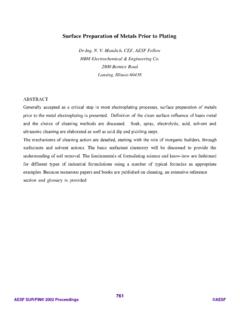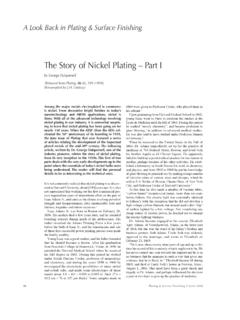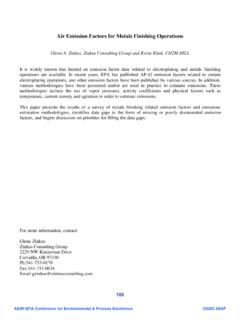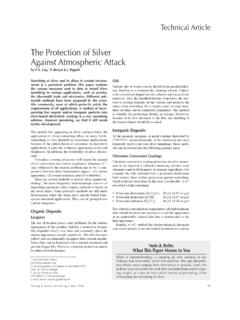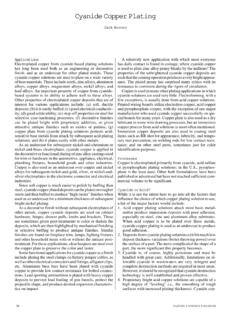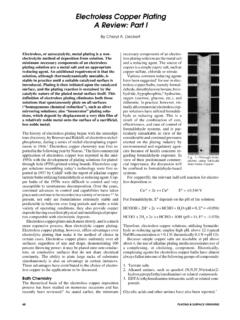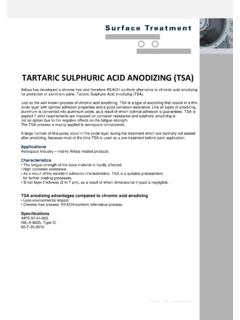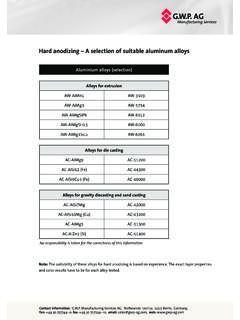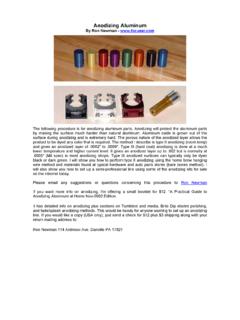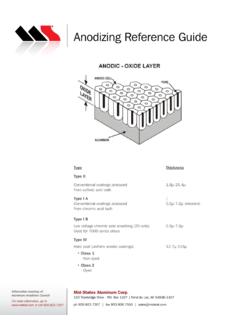Transcription of Troubleshooting of Electrolytic Color Anodizing of …
1 Troubleshooting of Electrolytic Color Anodizing of AluminumBob Srinivasan, Bob S. CONSULTING, Brookfield, Wisconsin, USAE lectrolytic Color anodized aluminum offers a highly durable finish for architectural and residential applications. The use of two-step Electrolytic Color Anodizing of extruded aluminum is widely prevalent in the industry. This article describes the basic process in brief, and then goes on to discuss the interdependency of the Anodizing and the Electrolytic coloring processes critical for Color uniformity and quality of finish. It offers some practical tips to avoid common problems and how to more information, contact:Bob Srinivasan845 Foxglove CourtBrookfield, WI 53045 Phone: (262) 789-0858E-mail: commercial and residential architecture, anodized aluminum (both clear and colored) has been widely used for doors, windows, and curtain walls.
2 In such applications, aluminum as extrusion and sheet metal are commonly used. Starting in the mid 1980 s, two-step Electrolytic coloring processes have been widely used throughout the industry to produce Color -anodized aluminum. They produce a variety of colors, commonly referred to as earth tone colors , ranging from champagne to medium bronze to dark bronze, and black. The resultant finish from such processes offer high corrosion and wear resistance, and the Color does not fade away when exposed to the UV light of the principles of the two-step Electrolytic Color Anodizing processAs the name suggests, there are two steps to this coloring process, and they are both Electrolytic . The first step is the Anodizing of the aluminum, and the second step is the coloring of the aluminum.
3 Because the Anodizing and coloring are done separately, the process can produce all the ranges of colors over anodic coatings of thickness from Class I and II. The Anodizing is done using the sulfuric acid process (generally with the addition of some kind of hard coat additive) and DC rectifiers. During the coloring process, an AC power supply is used, and it provides the traditional sinusoidal waveform, its modified waveform, or combinations of both. Many proprietary processes are commercially available for Electrolytic coloring. The electrolytes used in these processes are acidic and typically contain dissolved tin, hence the name, The Tin Process . To a lesser extent, cobalt and nickel are also used in coloring processes.
4 Although cobalt is considerably more expensive than tin, it can (unlike tin) produce a deep black Color over thin anodic coatings. Over the years, the tin process has become very popular, due to decreasing costs and more effective mentioned above, the first and most important step in the two-step Electrolytic coloring process is the sulfuric acid Anodizing of the aluminum. It is necessary to tightly control the concentrations of sulfuric acid, dissolved aluminum, and hard coat additive, as well as the bath temperature, air agitation, voltage, voltage ramp rate, and current density. Proper control of these variables yields anodic coatings that are both uniform in thickness and consistent in film characteristics, such as porosity and thickness of the barrier layer.
5 After the aluminum parts are anodized and thoroughly rinsed with water, they are immediately transferred into the Electrolytic coloring solution. They remain in the coloring solution for a minute or two, to let it penetrate and saturate the pores of the anodic coating before applying the AC current. During the Electrolytic coloring step, current passes through the pores and the barrier layer at the base of the anodic coating. The current causes the tin metal to be deposited into the anodic pores, starting at the base and building upwards. Because the porosity and the barrier layer of the anodic coating provide the path for the current to flow through during Electrolytic coloring, they greatly affect current efficiencies that cause metal deposition, thereby controlling the apparent Color and uniformity of the final 1.
6 Sketch of an anodic coating on aluminum - shows the barrier layer, anodic pores and the metal deposits at the base of the amount of the tin and its oxides deposited at the base of the anodic pores (Figure 1) is directly proportional to the refraction of light from the anodic film, which affects the apparent Color . If the deposited amount is low, the lighter colors of champagne and light bronze are formed. If the deposited amount is high, the darker and most popular colors of medium and dark bronze are formed. These two colors are widely used on extrusions that go into the fabrication of doors and windows installed on office buildings, shopping malls, and high-rise Tin ProcessAs mentioned earlier, the electrolyte used in the tin process for the Electrolytic coloring consists of an acid (usually sulfuric), dissolved tin salts, stabilizers, and Color enhancers.
7 The so-called counter electrodes used in the coloring bath could be soluble electrodes made of tin, or insoluble electrodes made of stainless steel or graphite. The AC power supplies could be simply manual, or they could come with programmable computer units. The coloring bath is operated at about 20 C (75 F) and with continuous circulation of the solution to cause a gentle rolling action at the & Electrolytic ColoringThe Electrolytic coloring can be imparted into anodic coatings of various film thicknesses. However, the resulting Color and its uniformity are mostly a reflection of the underlying anodic film characteristics such as porosity, barrier layer, etc. These film characteristics are greatly influenced by parameters such as Anodizing voltage, solution conductivity, uniformity of temperature, and air agitation within the solution.
8 Thus, without finding significant variances in the thickness of the anodic coating, one could find Color uniformity problems (within the same areas of an extrusion) due to variations of temperature and agitation within different areas of the Anodizing bath. These variations drastically alter the mentioned film characteristics, although they only have a minor effect on the anodic coating thickness. To state it paradoxically, what you don t see is what you get . Putting the Electrolytic coloring over the anodic coating is like taking an X-ray image of the anodic film underneath. It starts to reveal the defects that are invisible to the naked eye. For example, in areas of the Anodizing bath where there is little or no agitation (the hot zones ), the entrapment of heat would greatly increase the solution conductivity in that local area and lead to the widening of the anodic pores and thinning of the barrier layer.
9 These two, in combination, would cause the Color to shift towards a darker shade. The point here is that, while it is a common practice in an Anodizing shop to regularly and religiously check the anodic coating thickness, very little attention is paid to assure uniform air agitation and temperature of the bath. Often, they are neglected because there is no physical access for the operators and maintenance staff to investigate. Hence, it is advisable to have catwalks along all sides of the Anodizing tank, to provide ample access for the required service and common practices for Anodizing & coloringAlthough this paper deals with Troubleshooting , it is important to first mention the practices that help to prevent problems.
10 However, other factors do adversely affect the appearance of the colored finish. These include variations in the etching or bright dipping of the aluminum surface, variations in the sealing after the Anodizing and coloring, and variations in the alloy and tempering. These, and other factors, are beyond the scope of this paper. Hence, I have only listed the parameters of Anodizing and coloring that are critical to ensuring the standard Color uniformity. Racking Do not use titanium racks. Use only aluminum racks, preferably made of the 6063 T5 or T6 alloy. Ensure the aluminum racks are sized to carry the electrical current load. Make sure the aluminum racks are stripped before use, every time.
